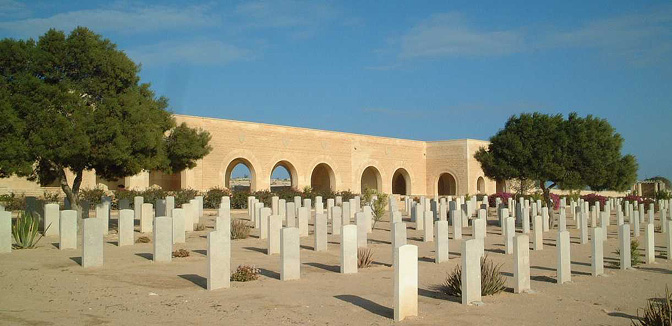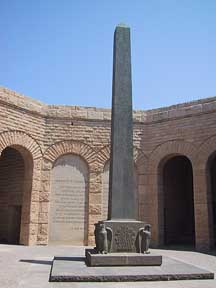by Samir Raafat
Egyptian Mail, October 12, 1996

|
|
|
|
|
Cheers to our "talented" literature prize awardee. Your pain his gain !!!
|
|
|
EGY.COM - LANDMARKS - CAIRO - HELIOPOLIS
|
|
by Samir Raafat
Egyptian Mail, October 12, 1996

The Battle of Alamein in which the reformed Allied Eighth Army successfully routed the Italian military and the dreaded Afrika Korps celebrates its 54th anniversary next week.
As usual a fitting ceremony attended by retired generals, ambassadors, WW2 veterans and their relatives will take place in the coastal town of Alamein. Conforming with established custom, the incumbency of these ceremonies are rotated between the Germans, the Italians and the British. According to Brigadier General Giancarlo Pascarelli Military, Naval and Air Attaché at the Italian Embassy in Cairo, this year's celebrations will take place on Sunday, 20 October at 09:30 and will be officiated by Francesco Aloisi de Larderel, Italy's ambassador to Egypt.
The Italians are pulling all the stops this year with the arrival in Alexandria of its top military brass including Admiral Ventoroni and General Incisa di Camerana, the Defense and Army Chiefs of Staff respectively. Also attending the celebrations on behalf of the Italian government is Signor Beniamino Andreatta, Italy's Minister of Defense (previously his country's minister of foreign affairs).
With the recent coincidental visit to Alexandria of the Italian aircraft carrier Garibaldi and its escort warship Lupo, one surmises the Italians are planning to assail our northern Mediterranean coast once again. "Not true" exclaims Marco del Panta at the Italian Embassy. "The Garibaldi and Lupo warships are in Alexandria as part of a joint exercise nicknamed Cleopatra 96."
The coming ceremony at Alamein is one of remembrance and recollection for those who gave their lives during the fiercest desert battle in modern history. The ceremony will be punctuated with the performance of Italy's martial band La Fanfara, according to del Panta.
Although half a century separates us from this bloodiest of desert wars, visitors continue to walk away from Alamein's memorial-mausoleums stunned by their sinister beauty and dramatic appeal. Despite what you have read in books or seen in movies, very little is known about the sad work that took place after hostilities were over, when the next to impossible task of searching for thousands of bodies began. These were strewn and scattered across the now silent but very scarred desert. The charred and decomposed remains had to be found, identified and properly buried before any of the WW2's survivors could sleep in peace.
According to notes left by the late Italian War Graves Commissioner Paolo Caccia Dominioni count of Sillavenco, himself a veteran of the Battle of Alamein, the bodies of 12,000 Italian soldiers were either buried in the soft sand dunes or lay under wild fig-tree groves. Worse still, many bodies had been dismembered by live minefields. Finding them and building a lasting memorial in their honor became Dominioni's raison d'ètre.
Ottokar Pauer, Dominioni's German counterpart and a professor of chemistry at Alexandria University, had an easier task. The German forces had been largely concentrated on the coastal area.
Great Britain's allies, Australia, New Zealand, South Africa, India and others, being the ultimate victors of this desert war, had had a head start in terms of amassing the dead soldiers under one roof.
Once the somber task of finding the bodies was completed it was time to erect the memorials.
It was in 1954 that the first memorial was inaugurated. It belonged to the Allies and was built by the Imperial War Graves Commission on land offered to the Commission by the people of Egypt. Situated north of the original cemetery where 8,000 soldiers had already been buried, an impressive shrine was gradually erected made up of a series of cloisters stretching on an east-west axis for almost 90 meters.
When Sir Hubert Worthington designed the above memorial he made full use of the surroundings when selecting the building material so that the main part of the building and halls were mostly made of white limestone carved out from nearby quarries. Only the pavings and copings made of Travertine marble were imported from Italy. The memorial's inside walls where you can find the fixed panels made of Portland stone bearing the 11,945 names of the fallen soldiers.
Field Marshal Viscount Bernard Law Montgomery unveiled the memorial on 24 October 1954. Coverage of the event was carried live by BBC's World Service--itself considered a technological feat considering these were still the radio days.
While several fellow soldiers accompanied their beloved Monty another four thousand civilians were reportedly in attendance.
Five years later another memorial was erected a few kilometers to the west. This was the 33-meter high, octagonal shaped Italian mausoleum designed and built by Cairo-based architect Paolo Caccia Dominioni who had been Italian War Graves Commissioner thirteen years earlier. Inaugurated on 9 January 1959 by the then-prime minister of Italy Amintore Fanfani, the memorial is situated on an area of 1,500 square meters leased out to the Italian government for 99 years. The names of 4,634 soldiers are inscribed. on the mausoleum's walls.
The third and last memorial to be unveiled in Alamein was the medieval looking Teutonic stronghold which stands on a ridge between the Allied and Italian cemeteries. It took three years to construct and was inaugurated on 19 October 1959.

The German memorial is the creation of Robert Tischler, principal architect of the German War Graves Commission. In this particular instance Tischler wanted to evoke Ancient Egyptian architects considered world masters when it comes to honoring the illustrious dead. Hence the 11.5 meter high basalt obelisk supported by four falcons purposefully located in the center of the mausoleum's inner courtyard.
On the German memorial's plates and mosaic panels, which hang in covered alcoves and burial chambers, are engraved the names of approximately 4,200 German soldiers. Just like the Allied mausoleums, the expanse of land on which the German mausoleum stands was offered to the German government by the people of Egypt.
The Alamein Anniversary is upon us once more and the gates of the three mausoleums will receive distinguished guests and silent mourners reminding all that there were no winners and losers in this most dreaded of wars. Only dead heroes and grieving widows. All of them very young.
|
|
|
|